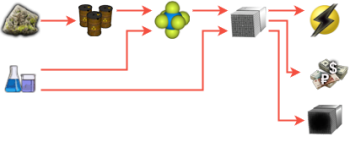Nuclear fuel
Nuclear fuel is a resources used for nuclear power plants in Workers & Resources: Soviet Republic.
Background
Nuclear fuel is material used in nuclear power stations to produce heat to power turbines. Heat is created when nuclear fuel undergoes nuclear fission.
Most nuclear fuels contain heavy fissile actinide elements that are capable of undergoing and sustaining nuclear fission. The three most relevant fissile isotopes are uranium-233, uranium-235 and plutonium-239. When the unstable nuclei of these atoms are hit by a slow-moving neutron, they frequently split, creating two daughter nuclei and two or three more neutrons. In that case, the neutrons released go on to split more nuclei. This creates a self-sustaining chain reaction that is controlled in a nuclear reactor, or uncontrolled in a nuclear weapon. Alternatively, if the nucleus absorbs the neutron without splitting, it creates a heavier nucleus with one additional neutron.
Not all types of nuclear fuels create power from nuclear fission; plutonium-238 and some other elements are used to produce small amounts of nuclear power by radioactive decay in radioisotope thermoelectric generators and other types of atomic batteries.
Nuclear fuel has the highest energy density of all practical fuel sources.
Gameplay
UF6 and chemicals are delivered to the nuclear fuel fabrication building, where workers and engineers are turning it over into Nuclear fuel.
Production
To produce Nuclear fuel, UF6 and chemicals must be delivered to an nuclear fuel fabrication building. In the nuclear fuel fabrication building workers and engineers turn the UF6 and chemicals into Nuclear fuel, packaged into containers. The maximum production per workday is 0.095t. The consumption rate is 0.40t UF6 and 0.75t chemicals for 0.095t nuclear fuel.
Storage
Nuclear fuel can only be stored in containers in a radiation protected storage, at the nuclear fuel fabrication buildings.
Transportation
They can be transported by using open-hull trucks, trains using open-hull cargo wagons, or by forklifts.
Uses
Notes
| Resources | |
|---|---|
| Aggregates | |
| Open storage | |
| Warehouse | |
| Liquid storage | |
| Other | |
| Utilities | |
| Dump | |
 Hooded Horse Wikis
Hooded Horse Wikis
